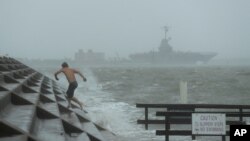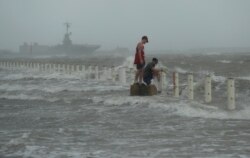Hurricane Hanna roared ashore onto the Texas Gulf Coast as a Category 1 storm on Saturday, bringing winds that lashed the shoreline with rain and storm surge, and even threatening to bring possible tornadoes to a part of the country trying to cope with a spike in coronavirus cases.
The first hurricane of the 2020 Atlantic hurricane season made landfall twice on Saturday afternoon within a little over an hour. The first landfall happened about 5 p.m., roughly 15 miles (24 kilometers) north of Port Mansfield, which is about 130 miles (209 km) south of Corpus Christi and about 70 miles (113 km) north of Brownsville. The second landfall took place around 6:15 p.m. in eastern Kenedy County, about 15 miles (24 km) north-northwest of Port Mansfield. As of Saturday evening, it had maximum sustained winds of 90 mph (145 kph).
Many parts of Texas, including areas near where Hanna came ashore, have been dealing with a surge in coronavirus cases in recent weeks, but local officials said they were prepared for whatever the storm might bring.
Corpus Christi Mayor Joe McComb said Saturday that he had seen some residents doing last-minute shopping for supplies, but he warned that if that hadn’t been done already, people should stay at home and ride out the storm.
“We’ve been staying at home for five months because of the corona[virus]. ... So staying home doesn’t sound real popular, but right now this is a real important matter,” McComb said, adding that residents should remember to wear masks if they have to evacuate their homes.
Steady rain fell Saturday in Corpus Christi and the winds got stronger.
Judge Barbara Canales, Nueces County’s top elected official, said officials were highly concerned about storm surge that was already moving inland. Live webcam footage showed waves sweeping over popular Whitecap Beach near Corpus Christi hours before the hurricane made landfall.
First responders in Corpus Christi proactively placed barricades near intersections to have them ready to go if streets began to flood, McComb said. More than 35,000 people throughout South Texas, including Corpus Christi, Harlingen and Brownsville, were without power early Saturday evening, according to AEP Texas.
Corpus Christi is in Nueces County, where health officials made headlines when they revealed that 60 infants tested positive for COVID-19 from July 1 to July 16.
Farther south in Cameron County, which borders Mexico and where Brownsville is located, more than 300 confirmed new cases have been reported almost daily for the past two weeks, according to state health figures. The past week has also been the county’s deadliest of the pandemic.
The main hazard from Hanna was expected to be flash flooding. Forecasters said Hanna could bring 6 to 12 inches (15 to 30 centimeters) of rain through Sunday night — with isolated totals of 18 inches (46 centimeters) — in addition to coastal swells that could cause life-threatening surf and rip current conditions.
Coastal states scrambled this spring to adjust emergency hurricane plans to account for the virus, and Hanna loomed as the first big test.
South Texas officials’ plans for any possible rescues, shelters and monitoring of the storm will have the pandemic in mind and incorporate social distancing guidelines and mask wearing.
Governor Greg Abbott said Saturday that some sheltering would take place in hotel rooms so people could be separated.
“We cannot allow this hurricane to lead to a more catastrophically deadly event by stoking additional spread of COVID-19 that could lead to fatalities,” Abbott said.
Rescuers on standby
Various resources and personnel to respond to the storm were on standby across the state, including search-and-rescue teams and aircraft. Mobile teams that can continue testing for COVID-19 were also being deployed.
Abbott said he had issued a disaster declaration for 32 counties in Texas and had asked the federal government to approve a similar declaration.
Tornadoes were also possible Saturday for parts of the lower to middle Texas coastal plain, forecasters said. A hurricane warning remained in effect for Port Mansfield to Mesquite Bay, which is north of Corpus Christi, and a tropical storm warning was in effect from Port Mansfield south to Barra el Mezquital, Mexico, and from Mesquite Bay north to High Island, Texas.
Mexico’s northeasternmost states, coastal Tamaulipas and Nuevo Leon just to its west, also took precautions ahead of the storm’s arrival. Tamaulipas was preparing shelters and disinfecting them to try to avoid spreading COVID-19, the state’s governor, Francisco Cabeza de Vaca, tweeted. Meanwhile, the civil protection department was sending rescue boats and other equipment to northern Nuevo Leon because heavy rains were expected.
David León, the national director of the civil protection department, told Milenio TV on Saturday that as many as 800 shelters could be activated in the parts of Mexico that could be affected by Hanna.
In the Mexican city of Matamoros, which is in Tamaulipas and across the border from Brownsville, Texas, volunteers were keeping a close eye on Hanna, worried that the storm could affect a makeshift migrant camp near the Rio Grande where about 1,300 asylum-seekers, including newborn babies and elderly residents, have been waiting under the U.S. immigration policy informally known as “Remain in Mexico.”
Hurricane Douglas
Meanwhile, a Pacific Ocean hurricane, Douglas, was heading toward Hawaii on Saturday. Douglas was expected to be near the main Hawaiian Islands late Saturday night and will move over parts of the state Sunday and Monday. A hurricane warning was in effect for Oahu County.
And back in the Atlantic, the remnants of Tropical Storm Gonzalo were expected to move westward across the southern Caribbean for the next couple of days. Gonzalo was forecast to bring 1 to 2 inches (3 to 5 centimeters) of rain. Watches or warnings were no longer in effect.






